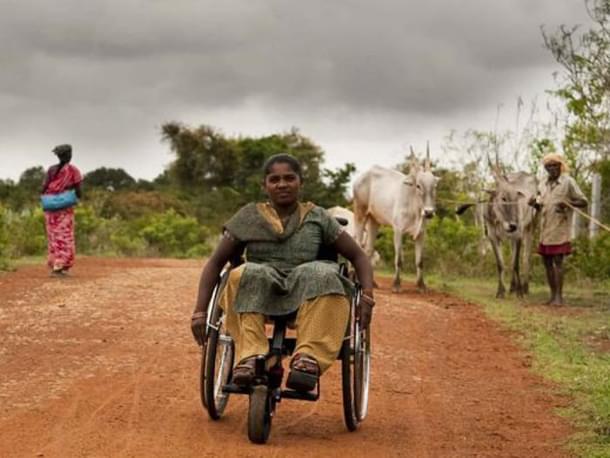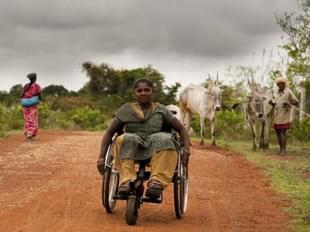Ideas
“Accessible India” Needs To Become More Accessible
Gaurav Goel
Nov 18, 2016, 12:19 PM | Updated 12:19 PM IST
Save & read from anywhere!
Bookmark stories for easy access on any device or the Swarajya app.


Management guru Peter Drucker had once famously said that if you cannot measure something, you cannot manage it. This adage pretty much sums up the problem with the efforts of all the previous (and present) Indian governments in providing dignified lives to “Persons with Disabilities” (PwD). It may sound a little unbelievable but a simple query to the ‘Ministry of Statistics and Programme Implementation’ on how many people in India suffer from disabilities would leave you with a plethora of data but practically little useful information.
The said ministry oversees both Central Statistics Office (CSO) as well as National Sample Survey Office (NSSO). Data on disability is collected both during census as well as through socio-economic surveys conducted by NSSO (1).
Unfortunately, both the departments use different yardsticks for measuring disability. So, someone with total hearing loss in one ear only would get classified as disabled in census 2001 but not so by NSSO. And to make matters worse, definitions used by both CSO and NSSO are not in consonance with the law enshrined in ‘People with Disability Act 1995’, which defines hearing impairment as loss of more than 60 dB in the better ear. This anomaly is not restricted to just hearing disability but prevalent across definitions for all disabilities.
In fact the definition of disabilities between census 2001 and census 2011 aren’t consistent either. This paradox of abundant data with little coherent information makes the task of formulating policy very difficult. Bibek Debroy, member NITI Aayog, had expressed dismay over this issue in an article written earlier this year for Indian Express.
Prime Minister Modi had launched Accessible India initiative in December 2015. It was for the first time that the Indian government had embraced the cause of PwD visibly. PM Modi has followed it up keenly by participating in the events including one on his birthday where he distributed helping devices to PwD.
As someone who himself uses such devices, I find this gesture heartwarming and considerate. Through the Accessible India website, citizens can upload photographs of public places that are PwD unfriendly and report to the authorities for remedial fix. One of the most interesting photograph on that website is that of a disabled “friendly” toilet in a public place accessible only after climbing one step. The sheer tokenism in that photograph is reflective of our society’s will in actually solving problems for PwD. And this is why my admiration for Accessible India campaign ends here.
Accessible India is not backed up by a proper legislative framework to protect the rights of PwD and give them an equal footing in leading a life of dignity. It was only in 1995 that India passed the “Persons with Disability Act “. While the Act must be lauded for visualizing a non-discriminatory society, it lacks stringent punitive measures for failure to comply. While it added mental illnesses as a disability, it contained an unsuitable definition of minimum 40 per cent failure in function as definition of disability. Strangely all government schemes for PwD, including scholarships for students, insist on disability certificate confirming 40% disability. Now compare this with USA’s ADA (Americans with Disability Act), enacted in 1990 by George H W Bush’s government. Not only does the act cover all aspects of everyday life like communications, transportation and workplace discrimination, it also defines punishment for non-compliance. As per a study published by the skill development ministry of government of Rajasthan on their website, the PwD act fares poorly, compared to ADA, in definition, implementation and enforcing compliance .
“ADA Watch is an effective watchdog system to monitor the implementation of the statute. The watchdog system under the PDA is not effective. ADA Watch has been operational since 1992. It reviews and evaluates on an ongoing basis, the effectiveness of all policies, programs and activities concerning individuals with disabilities. By January 1993, one year after instituting the ADA Watch they received 4200 complaints regarding discrimination. Advocacy groups are formed and formal suits are being constantly instituted in the courts. To cite a few examples of change made due to complaints made to ADA Watch - TV stations agreed to provide sign language interpreters for all programs they produced about elections. Disabled in Action Inc. sued a Philadelphia restaurant for not removing a small step that prevented access into the restaurant for wheel chair users.”
The United Nations adopted the Convention on the Rights of Persons with Disabilities (CRPD), signed by over 150 countries, in 2006 . India was among the first countries to ratify it in 2007. The CRPD charter required all signatory countries to pass a law to provide legislative backing to the provisions of CRPD and also to submit a CRPD State report, within 2 years of ratifying the treaty, to the overseeing UN committee. The Indian government failed miserably on both the counts. The UPA government started the process of drafting the new disability bill in 2011. It was started with a committee with very little representation from the PwD community. After the brouhaha that ensued, this anomaly was later corrected. The law school, NALSAR, was also involved in drafting the bill. However, the UPA government unceremoniously junked the 2011 draft prepared by the committee in favour of a new cabinet approved bill in 2013. The new draft was criticized by NALSAR on several counts and predictably they withdrew from the process. However, the UPA government introduced the bill in the Rajya Sabha only in February 2014 which was the last session of its tenure and could not get it approved by the Parliament. This bill has been criticized by the PRS Legislative Research on multiple issues such as conflicting with the existing laws, infringing on the rights of the state governments, etc (6). While the Modi government must be appreciated for not trying to push for the passage of this flawed bill, it's disappointing that the government has not replaced it with a better legislation either. A well framed law would have legally backed the credentials of Accessible India. Till that time it just remains a mass awareness programme. In May 2016, there were news reports about the new draft bill being sent to the PMO for consultation (7). But sadly the government seems to have put it on the backburner and there have been no developments on that front since then. It has been 10 years since India became a signatory to CRPD in 2006, it shows the apathy of Indian government in fulfilling the requirements of the treaty for its own citizens from PwD community.
Now coming back to the second issue which was India sending the state report on CRPD as required by the treaty, India submitted its first report only in Nov 2015 – 6 years too late. But the issue wasn’t limited to just the unacceptable delay. This report, available on the website of UNHCR, is full of factual inaccuracies. For instance, Article 21 of CRPD – “Freedom of Expression and Opinion and Access to Information”, entry 141 requires the government to promote sign language. Shockingly, the compliance report submitted by India points to the presence of website www.deafsigns.org as the proof of promotion of sign language. It even goes on to state that anyone who can access this website can learn the sign language through the short videos given on the website. If this ridiculous statement was not outrageous enough, the above mentioned website exists only the sake of formality. It contains no data, text or videos. Nothing. Nada. Zilch.
Indian governments’ (previous and present) efforts can therefore best be summed up as mere tokenism. In reality PwD remain the 2nd class citizens in a 3rd world country, deprived of basic rights to education, skill and empowerment at large. Unfortunately, Accessible India remains flawed without a backing legislation and offers no hope of redemption. I shall leave you with a haunting image from Accessible India website posted by a student, Priyanshu Kumar, from Purnea, Bihar who has been forced to climb stairs on his wheelchair for the last five years. Till we can make it possible for him to sue the government and school for non-compliance of a strong empowering law, Accessible India would just remain a pipe dream.





